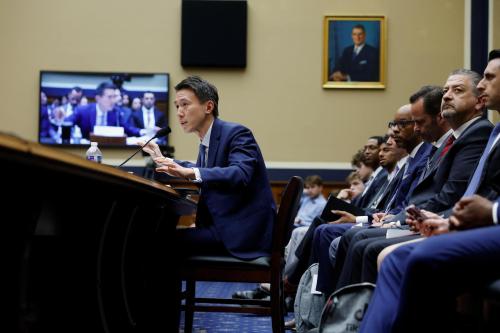In a matter of days, the Government Accountability Office (GAO) will release a report on what economic advantages, if any, are enjoyed by banks considered “too big to fail.” Authored at the request of Senators Sherrod Brown (D-Ohio) and David Vitter (R-La.), the GAO report will shed light on the effects and complexities of “implicit subsidies” often received by larger banks.
In advance of the report, Brookings Economic Studies Fellow Douglas Elliott has provided an excellent primer on implicit subsidies—what they are, why we care, and what questions need answering before we decide whether or not to break up, or heavily penalize, the largest banks.
We’ve pulled out some highlights from the primer below, but you can read it in full here.
What Are Implicit Subsidies?
A subsidy, in general, is any form of economic value given by the government to a bank. “Implicit subsidies” are different from direct subsidies because they are often unstated. Rather, they result from big banks paying less for their funding because depositors, investors, and trading counterparties assume that taxpayers would rescue these banks in a crisis, thus protecting the value of their investment during a crisis.
Why Do We Care?
We care because implicit subsidies are damaging to the economy, Elliott argues, for at least two reasons.
- They distort competitive dynamics by encouraging smaller banks to grow into big banks and gain these implicit subsidies.
- They erode market discipline on those banks that take excessive risks, due to government protection.
In efficient markets (sans implicit subsidies), banks would be discouraged to take such risks. Overall, implicit subsidies create policy problems by giving big banks a competitive advantage, Elliott says. But he also emphasizes, they can be offset by other requirements or taxes on the larger banks. That is why it is critical to look at the net implicit subsidy compared to smaller banks.
What Theoretically Determines a Bank’s Level of Subsidy?
All else being equal, determining gross subsidies would be based off these factors:
- The probability of the need for a rescue.
- The probability that the government would actually provide such a rescue.
- The portion of the security’s value that would be spared a loss by a rescue.
Further factors are necessary when comparing net subsidies of smaller banks:
- The gross subsidy for the smaller banks, if any.
- The net economic effect of other costs differentially imposed on the largest banks(taxes and regulations).
How does this play out in the real world? Here’s a wonky example from Elliott’s primer:
An investor might think there was a 1 percent chance each year of a particular large bank’s failure, absent rescue measures. He or she might further believe that a rescue in a crisis was 75 percent likely and that the loss would be 40 percent, absent a rescue (a fairly typical loss for a senior bondholder in bankruptcy), and zero with government intervention. Under these assumptions, it would be reasonable to expect the investor to lower their demanded annual interest rate by 0.30 percent, also known as 30 basis points (or bps). (This would be 1 percent times 75 percent times 40 percent.) For reference, a 1 percent annual probability of default is quite high for a bank and would generally be consistent with a junk credit rating, well below the average rating for the largest banks.
Why Are They So Hard to Measure?
Because they are determined based on the perception of government involvement. Additionally, there are many differences between the largest banks and the smaller ones that affect price variation without reflecting potential government support. All this means that analysts must determine if these subsidies come from the implicit guarantees of the government or other factors. These may include: Differences in business models and funding sources, litigation risks, risk diversification and others can factor into a larger banks competitive advantage to a smaller one.
Do These Implicit Subsidies Only Apply to Larger Banks?
According to Elliot: No. Some of these implicit subsidies also apply to smaller banks. For example, federal deposit insurance applies to all banks large and small. The federal government or the Federal Reserve may also take action to back smaller banks as well in times of crisis to save the banking system as a whole, and not just the largest banks, voiding any implicit subsidies toward the larger banks.
How Can We Fix the Problem?
- Change the underlying causes by eliminating the need for a rescue and/or reduce the level of risk during a crisis. If the markets perceive an implied government guarantee for the largest banks, it may be because there is in fact the likelihood of such a rescue. Fixing potential problems in Title II of Dodd-Frank or introducing some other mechanism to handle distress at systemically important banks could help reduce banks’ likelihood of a needing rescue.
- Change the market perceptions, if they lag reality. Even if public policy demonstrates that legislation and regulation are fixing problems caused by banks that are “too big to fail,” poor communication might mean markets are receiving the message. It may take another crisis—and government not rescuing the banks—to convince the markets, but absent such a situation, communication efforts could improve market perceptions.
- Offset the subsidies with taxes and capital requirements for these larger banks, helping the smaller bank compete. By raising taxes, capital requirements, or other regulatory burdens on the larger banks, the government can offset the remaining net implicit subsidy.
Download Elliott’s full primer here.
Delaney Parrish, Cory Coose, and Elina Saxena contributed to this post.


Commentary
Do Big Banks Have a Competitive Advantage from Government Policies?
July 28, 2014